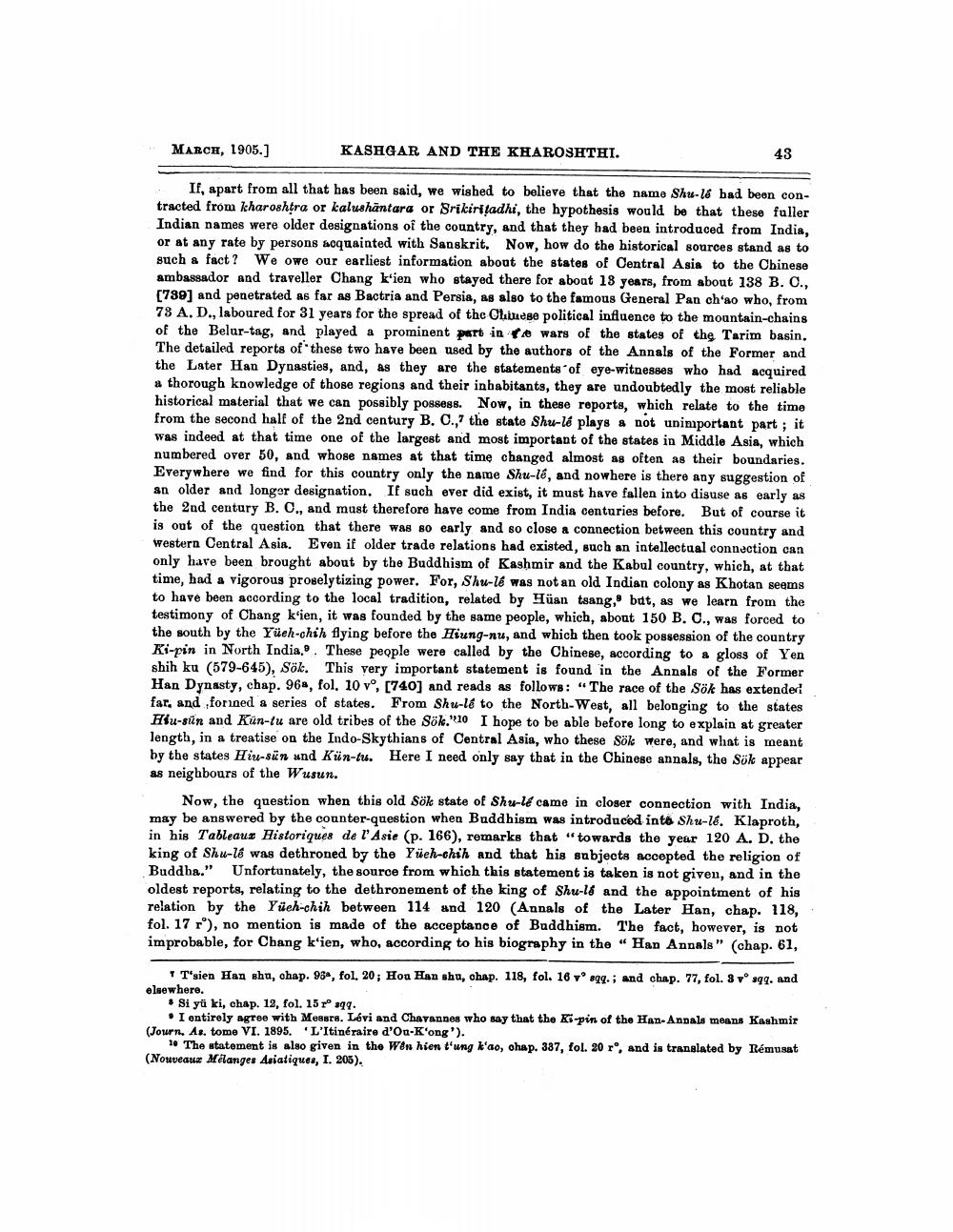________________
MARCH, 1905.]
KASHGAR AND THE KHAROSHTHI.
If, apart from all that has been said, we wished to believe that the name Shu-lé had been contracted from kharoshtra or kalushäntara or Srikiritadhi, the hypothesis would be that these fuller Indian names were older designations of the country, and that they had been introduced from India, or at any rate by persons acquainted with Sanskrit. Now, how do the historical sources stand as to such a fact? We owe our earliest information about the states of Central Asia to the Chinese ambassador and traveller Chang kien who stayed there for about 18 years, from about 138 B. C., [739] and penetrated as far as Bactria and Persia, as also to the famous General Pan ch'ao who, from 78 A. D., laboured for 31 years for the spread of the Chinese political influence to the mountain-chains of the Belur-tag, and played a prominent part in te wars of the states of the Tarim basin. The detailed reports of these two have been used by the authors of the Annals of the Former and the Later Han Dynasties, and, as they are the statements of eye-witnesses who had acquired a thorough knowledge of those regions and their inhabitants, they are undoubtedly the most reliable historical material that we can possibly possess. Now, in these reports, which relate to the time from the second half of the 2nd century B. C.,7 the state Shu-le plays a not unimportant part; it was indeed at that time one of the largest and most important of the states in Middle Asia, which numbered over 50, and whose names at that time changed almost as often as their boundaries. Everywhere we find for this country only the name Shu-lé, and nowhere is there any suggestion of an older and longer designation. If such ever did exist, it must have fallen into disuse as early as the 2nd century B. C., and must therefore have come from India centuries before. But of course it is out of the question that there was so early and so close a connection between this country and western Central Asia. Even if older trade relations had existed, such an intellectual connection can only have been brought about by the Buddhism of Kashmir and the Kabul country, which, at that time, had a vigorous proselytizing power. For, Shu-le was not an old Indian colony as Khotan seems to have been according to the local tradition, related by Hüan tsang, but, as we learn from the testimony of Chang k'ien, it was founded by the same people, which, about 150 B. C., was forced to the south by the Yüeh-chih flying before the Hiung-nu, and which then took possession of the country Ki-pin in North India.". These people were called by the Chinese, according to a gloss of Yen shih ku (579-645), Sök. This very important statement is found in the Annals of the Former Han Dynasty, chap. 96a, fol. 10 v°, [740] and reads as follows: "The race of the Sök has extender! far, and formed a series of states. From Shu-lé to the North-West, all belonging to the states Hiu-sün and Kün-tu are old tribes of the Sök."10 I hope to be able before long to explain at greater length, in a treatise on the Indo-Skythians of Central Asia, who these Sök were, and what is meant by the states Hiu-sün und Kün-tu. Here I need only say that in the Chinese annals, the Sök appear as neighbours of the Wusun.
43
Now, the question when this old Sök state of Shu-le came in closer connection with India, may be answered by the counter-question when Buddhism was introduced into Shu-lé. Klaproth, in his Tableaux Historiques de l'Asie (p. 166), remarks that "towards the year 120 A. D. the king of Shu-le was dethroned by the Yüeh-chih and that his subjects accepted the religion of Buddha." Unfortunately, the source from which this statement is taken is not given, and in the oldest reports, relating to the dethronement of the king of Shu-lé and the appointment of his relation by the Yüeh-chih between 114 and 120 (Annals of the Later Han, chap. 118, fol. 17 r°), no mention is made of the acceptance of Buddhism. The fact, however, is not improbable, for Chang k'ien, who, according to his biography in the "Han Annals" (chap. 61,
T'sien Han shu, chap. 95, fol. 20; Hou Han shu, chap. 118, fol. 16v sqq.; and chap. 77, fol. 3 v° sqq. and elsewhere.
Si yü ki, chap. 12, fol. 15 r° sqq.
I entirely agree with Messrs. Lévi and Chavannes who say that the Ki-pin of the Han-Annals means Kashmir (Journ. As. tome VI. 1895. 'L'Itinéraire d'Ou-K'ong').
10 The statement is also given in the Wen hien t'ung k'ao, ohap. 337, fol. 20 r°, and is translated by Rémusat (Nouveaux Mélanges Asiatiques, I. 205).




